Sinclair DNA - Our I1 Lineage and the I1 Anglo-Saxon Norse
Click any one of these to follow the I1 lineage's complete path through time
 |
 |
 |
Understanding the
formation of the I1 lineage after the LGM
This page will take you through whatever can be known about the I1
Haplogroup after the period of the LGM. This is the period I chose in
this lineage to stop studying their early migrations and to begin to
study their lineage splits as they, like many of us, seem to have
developed key SNPs during or just after the LGM. Unlike many of the
other lineages, they seem to have "sprinted" north to get to the
Germanic lands and to have survived primarily on hunting.
I1 is overwhelmingly a
Norse / Northern Germanic Haplogroup.
Most archaeological evidence in Scandinavia points to the there being
post-LGM settlement there about 8,000 BCE. These were the reindeer
hunters and our I1 ancestors may have been among them. Unfortunately,
tracking these folks in Northern Europe during the time from 8,000 BCE
to the time of the Greek and Roman writers is very difficult. However,
there were sources at work and there are many clues to be found in
studying the social structure of the countries over which these Norse
peoples gained influence.
Two of the key authors, albeit much debated, regarding the people of
the north were Snorri Sturluson in his Edda and Saxo Grammaticus in his
Gesta Danorum.
The Edda were Old Norse poems written down in Iceland during the 13th
century. There are a major source of Norse tradition and mythology.
Some of the older poems are believed to have been in existence long
before their addition to this book and, therefore, to be a somewhat
reliable link to the Viking age as they were passed down verbally for
generations.
Saxo Grammaticus was the author of the first full history of Denmark
during or just after the late 12th century. 'Grammaticus' means 'the
learned,' 25
and he certainly proved he was with his 16-book heroic history of the
Danes called Gesta Danorum. 91
Odin, Myth? Or Real
Person?
Thor Heyerdahl proposed that Odin, long regarded as a mythical god, was
in fact a real man who was later so revered that he entered into the
realm of myth. Heyerdahl and Per Lillieström found interesting
indications in their work Odin (The search for Odin) that suggests that
there is a distinct possibility for Odin to be, in fact, a human chief
of a people called Asas that were located around the Azov-lake and Azov
in southern Russia, sometime between 100 BC - 300 AD. 125
The genealogies of the Anglo-Saxon kingdom in England suggest that
there was a human named Odin of Saxon descent. His name was Wodan and
apparently he lived sometime between 100 AD - 250 AD. 125
Other authors have said that Odin was real. Hugh Montgomery 122, 123 and
many other researchers have said that there were several names for this
Odin in many cultures. There are many names throughout the history of
the Germanic peoples that are now claimed to be one and the same by
many authors -
Wōden
Wōdanaz
Wuotan (Old High German)
Wodan (Low German and Dutch)
Wodan
(According to Jennifer Westwood, the day of the week Wednesday was
named after this character.)
Why Odin Matters to our
Sinclair Project
Hugh Montgomery has hypothesized a line of descent in which the
descendants of Odin intermarried with a line from the Davidic bloodline
of Jesus and Mary. Those who want to follow this line of reasoning are
often drawn to look for clues that the Sinclair family is either
descended of this line or was somehow involved with it. Montgomery
claims that all the major royal houses of Europe and even George
Washington are descended of these two lines. If so, we should find the
DNA markers of the Visigoths in their lineages. A thorough look at the
Washington family DNA site shows that not a single member of this
family has the S21 U106 Visigoth markers. You can see
those markers on the "DYS390=23" links at left. So far, no one has
proven that George Washington is a direct male descendent of the
Visigoths. Perhaps Montgomery means to say the he is not a direct
male-to-male (YDNA) descendant of the Goths. Who knows? I once heard a
great quote - "When you find one brick out of place, you'd better check
the entire wall." I think that applies here.
Perhaps someday, someone will take the time to test Montgomery's
theories
against all the families mentioned using DNA and actual scientific
method. The Sinclair family has members who show the tell-tale markers
of Anglo-Saxon Visigoth invaders. Is this proof that they are descended
of this bloodline of Jesus and Mary, and connected to Odin? First,
you'd have to believe there is a bloodline of Jesus and Mary. Then you
have to believe Odin was a real person. Of course, it can't yet be
ruled out. That's the beauty of provisional historians - you can't
disprove them, so they continue to sell books and movies because their
conspiracy theories are fun to tinker around with.
Early History of the I1
Haplogroup in Scandinavia
Northward migrating humans arrived in Denmark by about 10,000 BC after
the end of the LGM. The first Danes were Stone Age hunters and
fishermen. However about 4,000 BC farming was introduced into Denmark.
The earliest Danish farmers used stone tools and weapons. However about
1,800 BC bronze was introduced into Denmark. 127
The lands where the I1 Haplogroup members began to settle were affected
by the LGM and its eventual retreat more than any other regions of
Europe. When the ice melted, the land was relieved of billions of tons
of immense weight. This resulted in a rising of the land and an
expansion of arable coastline. Naturally, what followed was greater
human settlement. 19,
p. 33
The accessibility between Scandinavia and Danish lands to the south
has always been a factor in the settlement of the north and the culture
and politics of both regions. The Jutland peninsula and its islands to
the east were just a short distance from Scandinavia.
Of course, this area was shortly to be overrun with the members of the
R1b Haplogroup. Scandinavia was a coastal culture. Much of these lower
lands were
covered with coniferous forests. The southern lands were a mix of
coniferous and deciduous forests, perfect for building ships. 19, p. 32 With
the rich fishing grounds of the Baltic, they eked out a successful
living.
Neil S. Price says the entrance to the Baltic was covered with a land
bridge as the ice retreated and, by 9,000 BC, people had moved into all
of Denmark, southern Sweden and perhaps even western Norway. 129
Price says the Hamburg, Federmesser, Bromme, and Ahrensburg people
developed successively in southern Scandinavia through the early Stone
Age. Others appeared in Northern Scandinavia - namely the Komsa and
Fosna cultures. 129
I suspect these were the R1a Haplogroup.
"A modal haplotype for all of I1 would not be meaningful because the
various varieties of I1 have not shared a common ancestor for thousands
of years, but key markers do unify the subclade (highlighted in red in
the table). Among European haplotypes, DYS455=8 is virtually exclusive
to I1; and YCAIIa,b=19,21 is universal to it. DYS511 has proven to be a
useful marker for separating AngloSaxon and Norse/ultraNorse varieties
of I1, it's value being 9 for the former and 10 for the latter. DYS462
is also useful for separating AngloSaxon vs. Norse/ultraNorse, being 12
in the former and 13 in the latter, though this marker is not part of
FTDNA's 67-marker set, so has to be tested "a la carte" at FTDNA or
elsewhere."
There are two main
subgroups of haplogroup I:
I-M253/I-M307/I-P30/I-P40 has highest frequency in Scandinavia,
Iceland, and northwest Europe. In Britain, haplogroup I-M253 is often
used as a marker for "invaders," Viking or Anglo-Saxon.
I-S31 includes I-P37.2, which is the most common form in the Balkans
and Sardinia, and I-S23/I-S30/I-S32/I-S33, which reaches its highest
frequency along the northwest coast of continental Europe. Within I-S23
et al, I-M223 occurs in Britain and northwest continental Europe. A
subgroup of I-M223, namely I-M284, occurs almost exclusively in
Britain, so it apparently originated there and has probably been
present for thousands of years.
Expressed differently and perhaps more clearly, this chart makes it
clear where our members fall - on the left, that SNP called M253. As
you can see, just below that are the indicators of deeper SNP testing
that will be able to better pinpoint our members to a specific
geography and a time period.
The Eve of the Viking Age
In the 880's, a Scandinavian merchant named Ottar was visiting the
Anglo-Saxon king Alfred and describing his homeland. Luckily for us, a
royal scribe was taking notes and these survive to this day. 129, 132 Ottar
described the far north of Norway and the western shore of the Baltic
as a home to several different cultures. With archaeological evidence
and these scant written reports, scientists have been able to
reconstruct a good history of the people of this region.
At this time, Scandinavia was primarily divided into the Saami
(pronounced "Sar-mee") people of the north and those of Germanic
origins in the south. Slavic and Baltic tribes were also present in the
southeast. The language patterns of the Saami are of Finno-Ugrian
origin 129, p 38
and distantly related to the Estonians and Hungarians. This
may fit nicely with a different path into Scandinavia and a different
SNP. My own theory is that the Saami arrived from a northern route and
were the ancestors of the R1a Norse while the rest arrived from the
south in steady and ongoing expansions from the Germanic tribes. But I
leave that up to the experts. I have no doubt but that our I1 members
are of the Germanic inhabitants of Scandinavia.
There is some debate about who came first and that argument seems to
take on near racist overtones. But I believe it's worth noting as it
may have had an effect on the later developments. From what I'm reading
at this writing, the southern group became the Viking invaders while
the Saami were more settled.
Around the year 700, there may have been as many as seven or eight
small kingdoms along the Norwegian coast. The territory of Sweden was
dominated by the two kingdoms of the Svear and the Goths. By 800, these
different groups had become tightly consolidated. The only holdouts
were Aland and Gotland, who remained independent.
In trading, and likely other matters, the Svear were oriented towards
the east while the Goths were oriented towards Denmark and Norway in
the west. The Saami of the north were oriented towards the west as far
as Iceland and Greenland. The drastic changes in boat building after
about 750 led to large scale changes in all Scandinavians except the
Mountain Saami.
However none of these changes in boat technology had any direct effect
on the Mountain Sámi. In the post-Viking period, while the
Coastal Sámi became increasingly more sedentary,
specializing in fishing or adopting animal husbandry and sometimes
agriculture, the Mountain Sámi preserved a more ancient
economy based on long-distance mobility and an economy of fishing, fur
trading and wild reindeer hunting. Mobile bands of hunters used the
mountains seasonally, operating from their winter camps that were
located along the major rivers and lakes in the foothills zone about
150 km to the east. 133
Scandinavians were late in adopting the use of sails on their ships,
about 700 AD. 134
but by 800, they had ships capable of the expansion that made
the Vikings feared throughout coastal Europe and beyond.
Today, Lindisfarne. Tomorrow, the world.
A lengthy discussion of Viking raids is not useful here. What is useful
is to understand where this I1 DNA spread, because it should follow the
path of the Vikings. The problem is, it also follows the R1a expansion
and the R1b DYS390=23 expansion in some cases.
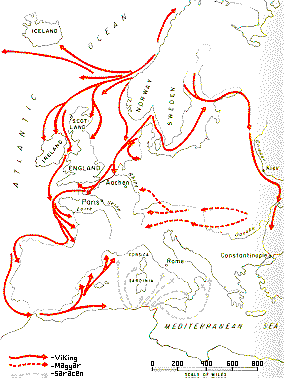
If the origination points can be believed, then one might be better able to understand which tribes went to which destinations. And, if one believes the Saami were focused west, then one might postulate they raided in the same directions. I'll look into this over the coming year. What I can look into now is the regional distribution of DNA in those lands invaded.
Herzegovinians 63.8%,
Croats ~48.0%
Sardinians 42.3%
Bosniaks 42.0%
Norwegians 40.3%
(See maps below for density)
Unfortunately, as in many things with the study of DNA, it's not completely clear cut. These are also the lands in which R1b is very densely packed. R1a also makes a heavy appearance.
Where Are They Now?
Note the current density of I1 in Scandinavia. This is one of the true Norse markers, yet it's found as widely dispersed as the western Black Sea.
Viking raids from 793 to about 1,000 AD.
The descendants of the MRCA of I1 today are primarily found among the Northern Germanic populations of northern Europe and the bordering Uralicand Celtic populations in Scandinavia, even though they're overshadowed by the dense R1b Haplogroup in the same areas. Look at the density in Scandinavia. But there are also high concentrations in the Balkans and on the north side of the Black sea.
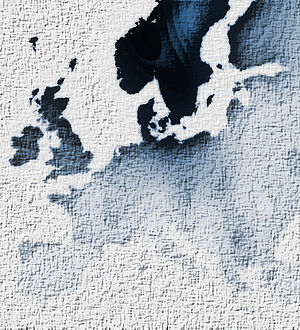
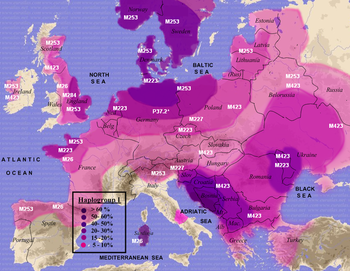
A Word of Caution
We're not looking for THE ONE TRUE VIKING LINEAGE here. To choose one haplogroup and say they were the definitive Vikings is simply wrong. The current distribution of haplotypes in the lands the Vikings invaded is simply not clear cut - these lands show a mixture of many different haplotypes. Even in parts of the world which have the highest concentration of I1, it still makes up only a portion of the population - 50% of western Finland, 40% in Sweden, and 30% of Iceland. As you can see in this chart, in the countries the Vikings invaded, R1b and R1a are about evenly represented and I1 makes a good showing, even in the UK.
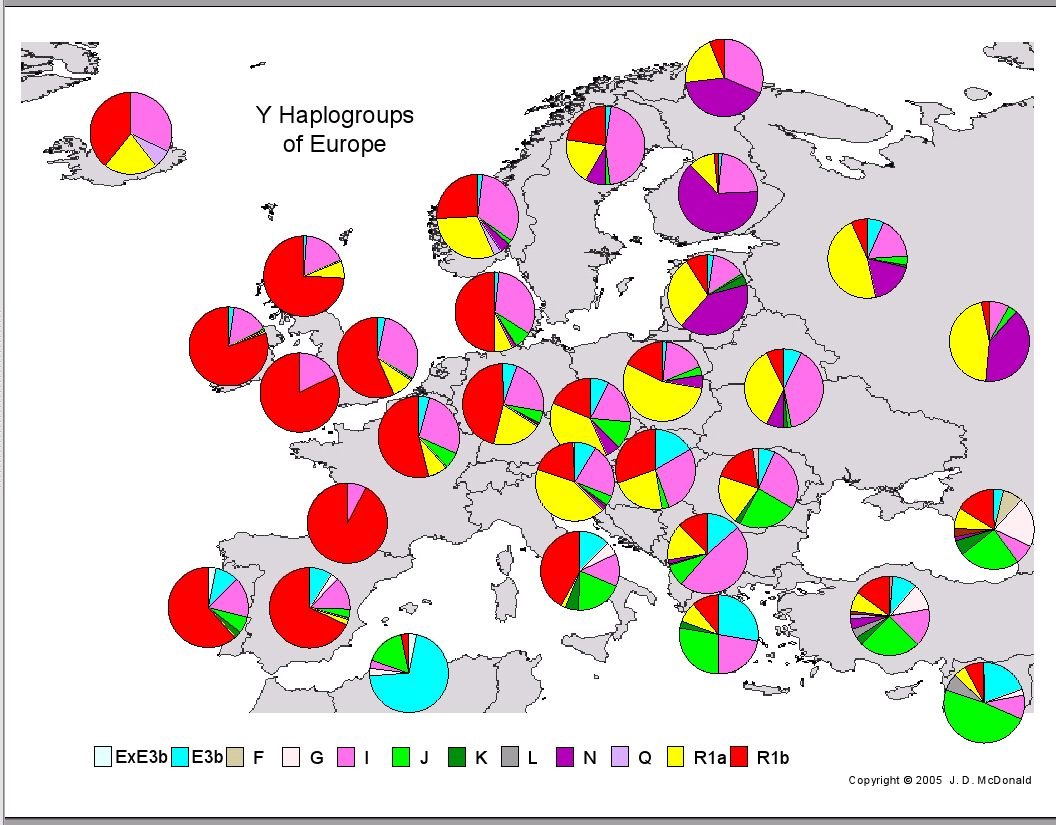
| Summary of Facts - The I1 Lineage and the I1 - Anglo-Saxon Norse |
| Somewhat
like the E1 group, the
ancestors of Sinclairs with the I1 haplotype spent some time in the
Balkans before finding their way into Northern Europe, then sprinting
up
into Scandinavia. Some of these I1 folks stayed in Scandinavian countries while others came south into Europe even before the well-known Viking raids. This haplogroup does not share a MRCA with other lineages until before the LGM when R1 split off into R1b and those who stayed in mid-Europe developed the mutation we call R1a. A clear 'modal haplogroup' divides our members in this lineage. One set of markers points to the likelihood of matching with Ken Nordtvedt's Anglo-Saxon Norse study. Others in this I1 group are not matching up with any of the 3 modal haplogroups identified by Nordtvedt. All members showing this haplotype are advised to contact Steve about Deep Clade testing. This haplotype shows up in Northern Scotland and was possibly brought there by early Norse contact, however, it's prevalence in all of Western Europe makes it very possible that they traveled with the Anglo-Saxon Visigoths or the Danes into England and then north into Scotland. |
| Further notes - 5 members, one is M-253 positive, All members require SNP testing...fast |
AMH | Germany | DYS390=25 | DYS390=23 | S21-U106 | Anglo-Saxon Visigoths
E1b | I1 | R1a | CCR5-Delta-32 | Mutation Rates | Lineage Smugness
Home | Contact | Join Google Discussion Group
